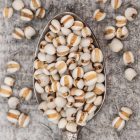Angela Warburton, R. TCMP
Have you been feeling a bit like a wet sponge with all the rain this summer? Do you find it hard to get moving in damp-humid weather or find yourself swelling easily making you feel like an overstuffed sausage in your favourite clothes? If you your joints scream out every time the weather shift comes you’re not alone…and there’s a reason for it!
Why is it that some people seem to fly though the damp days of summer with loads of energy and feeling great, where others get hit hard? The answer lies in our body ‘type’ or internal pattern according to Chinese Medicine (TCM) Theory.
In TCM we describe this waterlogged state as internal Dampness. Dampness relates to moister levels in the body. And, just like in nature, when you soak something in water overtime, it swells. The same is true for people. People who have what we’d term a damp pattern tend to retain water easily, swell and bloat with humidity and may find certain ailments (sore knees or low back, headaches or a feeling of foggy headedness or congestion) all get worse in the humid weather or in damp environments (think damp and musty basement or a rainy city like Vancouver or Seattle).
Dampness can be caused by a few patterns in the body – not enough heat (just think desert compared to wet lands…the main element missing is the sun/heat), or sometimes a diet, environment or lifestyle that has too much moisture in it will contribute to the imbalance.
Luckily, there are lots of little things that you can do to help bring balance back to your body and lessen some of the damp symptoms you are experiencing. Little things make a huge difference over time, so keep at it and the next time we’re having a wet spell, your body will be better able to handle it!
Signs of Internal Dampness:
- Heavy feeling in limbs or body, mucus or sinus congestion,
- Heavy or foggy headed (like there’s a wet towel wrapped around it), Achy puffy joints,
- Loose bowels or fatigue after meals
- Chronic candida or fungal infections, or prone to yeast infections or vaginal itching
- Trouble losing weight, thirst with very little desire to drink
- Easily retain water – oedema or swellings (e.g. I have difficulty taking my rings off or often have indentations from your socks), limbs often feel heavy and tired, Cloudy urine, bruise easily, sticky taste in my mouth, craves sweets,
- Worry, fret or over think. A lot.
- Prone to cysts or lumps (including some fibroids, lymph-nodes, swelling, lipomas, cysts, PCOS, polyps)
- Tongue often feels swollen or ‘big’ in your mouth. There are teeth-marks or scalloped edges on the sides of your tongue
What to do
Healing Foods:
▪ Eat foods lower on the glycemic index to help stabilized blood sugar levels (low sugared and avoid processed foods)
▪ Include job’s tears or barley in your diet regularly (it helps to rid the body of excess moisture)
▪ Green tea (add ginger if you run on the cold side)
▪ Warm foods and spices (if you’re a cold and damp mix)
▪ Dry roasted or slow roasted foods can be helpful
▪ Spices: caraway, celery, coriander, horseradish, marjoram, parsley, add warming spices such as white pepper, dried ginger, fennel etc. if you’re on the cold-damp side,
▪ Bitter foods help the body with ‘damp’ conditions: rapini, romaine, kohlrabi, rye etc.
▪ Teas: Chamomile, barley, hawthorn or fennel, are helpful for digestion
▪ Vegetables: turnip, daikon radish, celery, lettuce, pumpkin, scallion, alfalfa, kohlrabi, asparagus
▪ Grains: amaranth, rye, job’s tears, barley
▪ Include more bitter and pungent flavours in your diet (bitter greens (dandelion, rapini, romaine, rye, radish, turnip, onion family etc.)
▪ Include more bitter and pungent flavours in your diet (bitter greens (dandelion, rapini, romaine, rye, radish, turnip, onion family etc.)
▪Lemon and lime
▪Umeboshi plum
Foods to Avoid:
▪ Dairy products – if you have any goats or sheep milk products are easier to absorb than cow’s
▪Avoid overconsumption of fluids (including water at meals). Opt more for a warm broth or sipping on a small amount of water. Thirst should dictate water consumption in the day, not what you think you ‘should’ drink. If your pee is clear/light coloured, you’re hydrated!
▪ Sugar and sweeteners in general (if you need something sweet, opt for natural sweeteners like maple syrup or raw honey which helps to rid the body of excess dampness (in small amounts)
▪ Avoid raw, cold or frozen foods
▪ Avoid ice cream!! Cold, damp and sweet – triple threat!
▪ Limit or avoid wheat products – damp types tend to react worse than others to wheat and often gluten products
▪ Heavy cream, fried or greasy foods
▪ Processed foods
▪ Avoid over consumption of animal products, eggs and fats and oily nuts
▪ Avoid soy and soy products
▪ Fermented/yeasty products if you’re prone to yeast/candida (beer, bread, soy sauce, wine, vinegar, mushrooms, blue cheese)
▪ Excessive salt, Rich or fatty greasy meats Saturated fats, Roasted Peanuts, Concentrated juices especially Orange and Tomato, Bread, Yeast, Beer, Bananas,
▪ Too many carbs like yams and sweet potatoes
Lifestyle:
▪ Move! Movement helps to metabolize water, boosts your metabolism and cut through the lethargy
▪ Try starting your day with a barley drink and lemon (See attached recipe)
▪ Try to make sure your meals are warm and cooked
▪ Try to exercise for at least 30mins/day, but listen to your body -Don’t over do it!
▪ Avoid damp environments and be sure to check for any mold that may be lingering in damp areas in your home. If your house is damp be sure to invest in a dehumidifier.
▪ Probiotics may be helpful on a regular basis
▪ Avoid late night eating or overeating – it causes a backlog of food and weakens the digestive system which can cause dampness
▪ Include more bitter and pungent flavours in your diet (bitter greens (dandelion, rapini, romaine, rye, radish, turnip etc.)
- In particular we need to avoid too much raw, cold, sweet or rich food and the overconsumption of fluid.
Lifestyle Tips and Recipes
Sea Salt Bath:
Add at least 2 cups sea salt (I find this works better than Epsom salts) to warm/hot water bath
Soak for at least 20-30 minutes.
This simple (and soothing) ritual will not only pull some of the retained moisture from your body, but also help your body detoxify. If you have a natural scrub brush, try exfoliating at the end of your soak as it’s great for smoothing out any rough or dry patches adds to the detox effect and makes your skin super soft and smooth!
Recipes
Barley or Job’s Tears Water:
 Barley water is a traditional drink consumed in various parts of the world. Drinking boiled grain in water, strained or not, is an ancient practice and has wonderful medicinal effects for the damp pattern.
Barley water is a traditional drink consumed in various parts of the world. Drinking boiled grain in water, strained or not, is an ancient practice and has wonderful medicinal effects for the damp pattern.
¼ cup hull-less barley or Job’s tears (yi yi ren)
4 cups water
Fresh lemon juice or rind
Dry roast barley first in pot. Add water and bring to a boil for 15minutes. Reduce heat and let simmer for 30-45 minutes or until grains is soft and falling apart and/or water has decreased to 2 cups. Strain barley; add juice of fresh lemon or lime.
You an also rinse the barley or job’s tears and soak them in a pitcher overnight and drink in the morning. The liquid will be cloudy which is totally normal. You can refill a few times over 2 days before replacing the grain.
Can also be diluted if desired. Sip on throughout the day or have a glass in the morning and evening to help with bloating and water retention.
Note on Job’s Tears:
Job’s tears are used as a herb in Chinese Medicine specific for damp patterns. The TCM name is Yi Yi Ren and they can be found easily in an Asian supermarket. They may also be under the names coix seed, Chinese pearl barley, or hato mugi in Japanese and looks very similar to barley.

